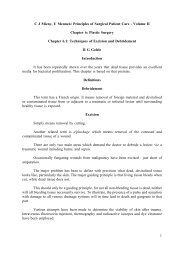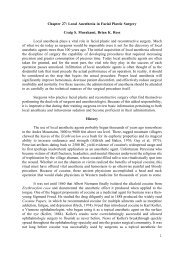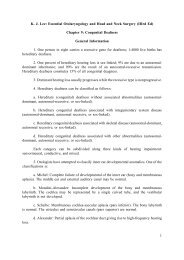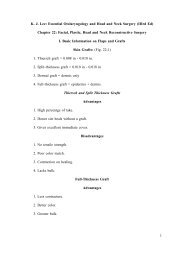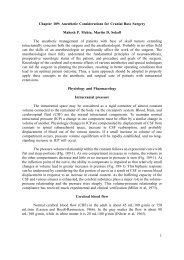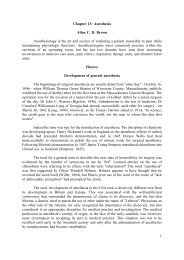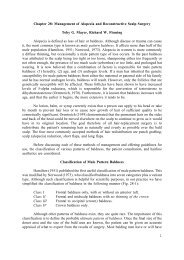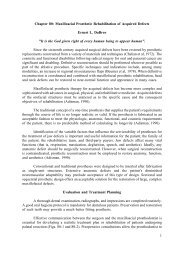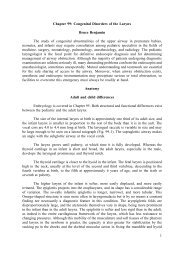1 Chapter 8: Skin Flap Physiology George S. Goding ... - Famona Site
1 Chapter 8: Skin Flap Physiology George S. Goding ... - Famona Site
1 Chapter 8: Skin Flap Physiology George S. Goding ... - Famona Site
Create successful ePaper yourself
Turn your PDF publications into a flip-book with our unique Google optimized e-Paper software.
Magnetic resonance imaging may be another way to investigate changes in the<br />
intercellular space after flap elevation. Interruption of the blood supply to the canine gracilis<br />
muscle flap resulted in a tendency for increased spin-spin relaxation time (T 2 ) but the sample<br />
was too small to be statistically significant (Greenberg et al, 1987).<br />
Attempts to Alter <strong>Skin</strong>-<strong>Flap</strong> Viability<br />
Kerrigan (1983) outlined extrinsic and intrinsic causes of skin-flap failure. Extrinsic<br />
reasons for flap necrosis are those not resulting from the design of the raised flap. Examples<br />
include systemic hypotension, infection, and pedicle compression. Often, these factors can be<br />
overcome in the clinical situation. The primary intrinsic factor affecting flap survival is<br />
inadequate blood flow. Numerous experimental attempts have been made to influence flap<br />
microcirculation and/or decrease the deleterious effects of inadequate flap blood flow. The<br />
most successful has been flap delay. Attempts to improve flap blood flow and cutaneous<br />
tolerance of ischemia have been less successful but continue to be active areas of research.<br />
Delay<br />
Four facts are accepted about the delay phenomenon. First, it requires surgical trauma;<br />
second, a large percentage of the neurovascular supply to the flap must be eliminated; third,<br />
delay results in increased flap survival at the time of tissue transfer; and fourth, the beneficial<br />
effects can last up to 6 weeks in the human (Pearl, 1984). To explain this phenomenon, three<br />
theories regarding the mechanism of delay have been developed: (1) delay improves the blood<br />
flow, (2) delay conditions the tissue to ischemia (McFarlane et al, 1965b), and (3) delay<br />
closes arteriovenous shunts (Reinsch, 1974). The most recent research supports a mechanism<br />
resulting in increased circulation to the flap, but how this occurs remains to be proved.<br />
Using microspheres Pang et al (1986b) found the percentage of arteriovenous shunt<br />
flow to be similar in delayed and acute flaps. The increased blood flow in delayed flaps was<br />
caused by an increase in total blood flow. The addition of systemic norepinephrine decreases<br />
the blood flow in delayed flaps to the level seen in acute flaps. The increased survival in the<br />
delayed flaps was thought to be caused by a decrease in vasoconstriction in the distal portion<br />
of the flap.<br />
<strong>Flap</strong>s delayed as little as 24 hours survive to a greater length (Sasaki and Pang, 1981)<br />
and can tolerate longer periods of ischemia (Weinberg et al, 1985, 1985). Using the<br />
microsphere technique, distal perfusion in the pig flank flap was found to increase with a<br />
delay up to 4 days. No further increase in perfusion was seen with continued delay up to 14<br />
days (Pang et al, 1986c). The early increase in blood flow was thought to occur too early to<br />
be caused by angiogenesis and a bipedicle flap design limited the effect of hypoxia as a<br />
stimulus. Pang et al (1986c) theorized that a modulation of the vasoactivity of the small<br />
arteries allowed delivery of more blood to the distal portion of the flap. This modulation<br />
could occur by release of vasoconstrictive substances (norepinephrine, thromboxane, and<br />
serotonin) during elevation of the bipedicled flap. Necrosis is not seen because the bipedicled<br />
flap has an adequate blood supply. Degeneration release of norepinephrine occurs soon after<br />
flap elevation and norepinephrine stores are largely depleted in the first 24 to 48 hours (Jurell,<br />
1986; Palmer, 1970). In bipedicle flaps, Cutting et al (1982) found that the catecholamine<br />
level started to rise 4 days after flap construction, whereas others (Jurell, 1986; Palmer, 1970)<br />
16




